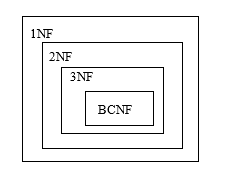10. NORMALIZATION
The theory of normal forms is concerned with the structure of relations in a relational database. There are several normal forms of which 1NF, 2NF, 3NF and BCNF are the most important for practical OLTP database design. OLTP stands for online transaction processing – OLTP systems are used to run the day-to-day events of a business.
Normalization theory gives us a theoretical basis to judge the quality of a database and helps one understand the impact of some design decisions. In practice Entity Relationship Modelling is the primary technique used for designing databases, and experienced practitioners will typically develop BCNF relations as a result. Normalization can be applied by the practitioner to understand better the semantics behind some relations and possibly make some design modifications.
1NF, 2NF, 3NF and BCNF are acronyms for first, second, third, and Boyce-Codd normal forms. There is a sequence to normal forms: 1NF is considered the weakest, 2NF is stronger than 1NF, 3NF is stronger than 2NF, and BCNF is considered the strongest of these four normal forms. Also, any relation that is in BCNF, is in 3NF; any relation in 3NF is in 2NF; and any relation in 2NF is in 1NF. This correspondence can be shown as:

BCNF relations are in 3NF
3NF relations are in 2NF
2NF relations are in 1NF
Transactions are units of work designed to meet the goals of users. For instance, in a banking environment we would expect to find a deposit transaction, a withdrawal transaction, a transfer transaction, and a balance lookup transaction. A unit of work is a collection of database operations that are executed in their entirety or not at all. For example, if you are transferring money from one account to another it’s important for the integrity of accounts that the transfer be completely done, and never partly done. If a transfer transaction is partly done (say, because of a system failure) then accounts would be out of balance. A database environment has capabilities to back out partly executed transactions so the system can be back where it was prior to a failed transfer transaction.
A banking system could have thousands of users and we expect transactions such as these to be correctly and efficiently executed. A normalized database is such that every relation is in at least 1NF, and preferably BCNF. Normalized databases lead to the most efficient designs for these types of transactions.
Normalization is a process that replaces a relation with other relations of a higher normal form. The process involves decomposing a relation into other relations in such a way as to preserve the original information and reduce redundancy of data. Reducing redundant data increases the number of relations but makes the data easier to maintain. Later we give examples of decomposition. We say normalization is a process that improves a database design. The objective of normalization is sometimes stated: to create relations where every dependency is on the key, the whole key, and nothing but the key[1]. A relation that is fully normalized is about a single concept such as a student entity type, a course entity type, and so on.
De-normalization is a process that changes relations from higher to lower normal forms, and hence generates redundant data in the tuples (rows/records) of a relation (table). If deemed necessary, this would be done to improve the performance (reduce the cost) of retrieving information from the database. The cost of querying de-normalized relations is generally less because fewer joins are required.
We consider higher normal forms to be better because the update semantics for data are simplified. By this we mean that applications required to maintain the database are simpler to code and so they are easier to maintain. In the following we discuss:
-
-
- Functional Dependencies
- Update Anomalies
- Partial Dependencies
- Transitive Dependencies
- Normal Forms
-
[1] Kent, William. “A Simple Guide to Five Normal Forms in Relational Database Theory”, Communications of the ACM 26 (2), Feb. 1983, pp. 120–125.

